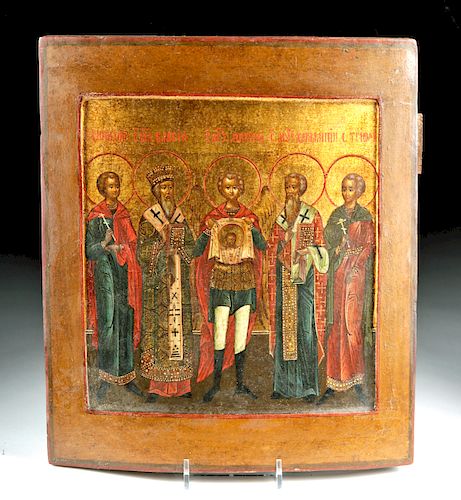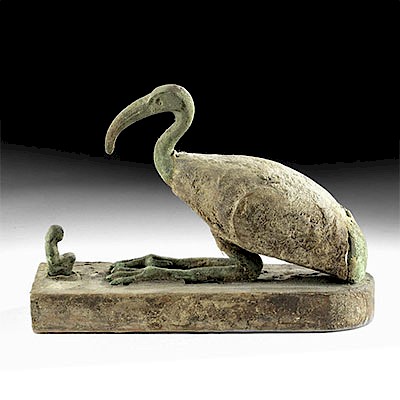19th C. Russian Icon - Archangel & Holy Face
Lot 274
About Seller
Artemis Gallery
686 S Taylor Ave, Ste 106
Louisville, CO 80027
United States
Selling antiquities, ancient and ethnographic art online since 1993, Artemis Gallery specializes in Classical Antiquities (Egyptian, Greek, Roman, Near Eastern), Asian, Pre-Columbian, African / Tribal / Oceanographic art. Our extensive inventory includes pottery, stone, metal, wood, glass and textil...Read more
Estimate:
$1,100 - $1,650
Absentee vs Live bid
Two ways to bid:
- Leave a max absentee bid and the platform will bid on your behalf up to your maximum bid during the live auction.
- Bid live during the auction and your bids will be submitted real-time to the auctioneer.
Bid Increments
| Price | Bid Increment |
|---|---|
| $0 | $25 |
| $300 | $50 |
| $1,000 | $100 |
| $2,000 | $250 |
| $5,000 | $500 |
| $10,000 | $1,000 |
| $20,000 | $2,500 |
| $50,000 | $5,000 |
| $100,000 | $10,000 |
| $200,000 | $20,000 |
About Auction
By Artemis Gallery
Oct 31, 2019
Set Reminder
2019-10-31 10:00:00
2019-10-31 10:00:00
America/New_York
Bidsquare
Bidsquare : Fine Antiquities, Asian, Ethnographic Art
https://www.bidsquare.com/auctions/artemis-gallery/fine-antiquities-asian-ethnographic-art-4581
Our Halloween Day auction features classical antiquities, ancient and ethnographic art from cultures encompassing the globe, plus fine art. Artemis Gallery info@artemisgallery.com
Our Halloween Day auction features classical antiquities, ancient and ethnographic art from cultures encompassing the globe, plus fine art. Artemis Gallery info@artemisgallery.com
- Lot Description
Eastern Europe, Russia, ca. 1850 CE. Finely executed in egg tempera, gold leaf, and gesso on linen and wood, a beautiful icon depicting an Archangel holding Veronica's veil which bears the frontal imprint of the Holy Face, between two bishops holding gospels, and two other clergy holding crucifixes. A stunning example with skillfully painted figures and accoutrements, inscriptions labeling each figure above, and copious amounts of glimmering gold leaf. Size: 12.25" L x 10.375" W (31.1 cm x 26.4 cm)
In the Eastern Christian world, the Holy Face is referred to as that of the Mandylion, the portrait of Christ sent to Edessa to cure King Abgar. This image was discovered inside a wall in the year 545 and transferred to Constantinople in 944. It was then exhibited in the Church of Hagia Sophia in Constantinople until the year 1204 when it disappeared during the Fourth Crusade. Some believe that it may correspond to the famous folded Shroud of Turin. The keramion (tile) that walled in the Mandylion during historic persecutions purportedly preserved a reverse image of this Holy Face. Three known Holy Face icons derive from the Mandylion of Constantinople: those of Novgorod, Laon (France), and Yaroslav. By contrast, according to Western belief, the portrait of Christ is a visage miraculously left by Jesus on a veil that Veronica used to wipe his face on Calvary, and the Golden Legend tells of Emperor Tiberius' cure by this veil which Veronica brought to him in Rome. The relic which is actually referred to as "Veronica" (stemming from vera icon meaning "true image") was purportedly copied many times before it was lost.
Provenance: private New Jersey, USA collection
All items legal to buy/sell under U.S. Statute covering cultural patrimony Code 2600, CHAPTER 14, and are guaranteed to be as described or your money back.
A Certificate of Authenticity will accompany all winning bids.
We ship worldwide and handle all shipping in-house for your convenience.
#143390Expected surface wear to the composition commensurate with age. Nice craquelure. Missing one back slat and inactive insect holes on verso.Condition
- Shipping Info
-
All shipping is handled in-house for your convenience. Your invoice from Artemis Gallery will include shipping calculation instructions. If in doubt, please inquire BEFORE bidding for estimated shipping costs for individual items.
-
- Buyer's Premium



 EUR
EUR CAD
CAD AUD
AUD GBP
GBP MXN
MXN HKD
HKD CNY
CNY MYR
MYR SEK
SEK SGD
SGD CHF
CHF THB
THB














